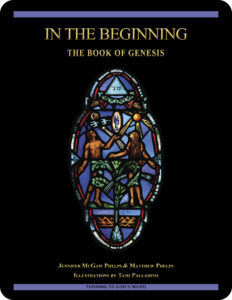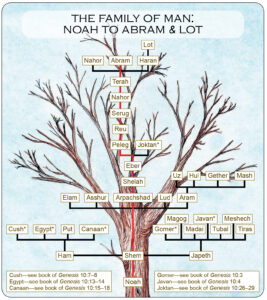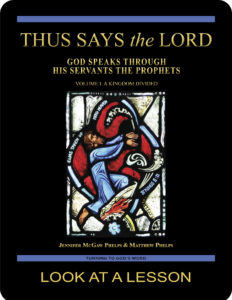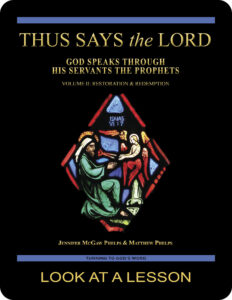 In the Beginning:
In the Beginning:
The Book of Genesis
Lesson 7 Canaan: A Slave of Slaves
the book of Genesis 9:18—11:32
Revised Standard Version Catholic Edition (RSVCE)*
New American Bible Revised Edition (NABRE)*
Catechism of the Catholic Church
ex libris (in our library)
cross references in the book of Genesis
next lesson: The Call of Abram
This material coordinates with Lesson 7 on pages 38–43 in the study book In the Beginning: The Book of Genesis.
“And God saw everything that he had made, and behold, it was very good. And there was evening and there was morning, a sixth day. Thus the heavens and the earth were finished, and all the host of them. And on the seventh day God finished his work which he had done, and he rested on the seventh day from all his work which he had done.”—the book of Genesis 1:31—2:2
welcome to our in-depth study of the book of Genesis
We invite interested groups and individuals to check out the sample first lesson from this 28-lesson  Turning to God’s Word Catholic Bible study.
Turning to God’s Word Catholic Bible study.  These online study pages link to our free lesson video overviews as well as to a list of cross references in the biblical text. Other study aids include maps, charts, illustrations, additional commentary, and prayers based on the primary Scripture in each lesson. In the Beginning: The Book of Genesis has been granted an imprimatur and can be purchased from our website shop. If you have a Bible-study question or comment, click on one of the “ask us your question” or “what do you think” buttons on any online study page.
These online study pages link to our free lesson video overviews as well as to a list of cross references in the biblical text. Other study aids include maps, charts, illustrations, additional commentary, and prayers based on the primary Scripture in each lesson. In the Beginning: The Book of Genesis has been granted an imprimatur and can be purchased from our website shop. If you have a Bible-study question or comment, click on one of the “ask us your question” or “what do you think” buttons on any online study page.
open with prayer
It’s always wise to begin any Bible study with prayer, whether reading the Scriptures alone or meeting with others in a discussion study group. You can pray using your own words or use one of the opening prayers on our website. We especially like the following:
Lord Jesus, you promised to send your Holy Spirit to teach us all things.
As we read and study your word today,
allow it to touch our hearts and change our lives. Amen.
let’s review—the book of Genesis 6:11—9:17
Lesson 6 The Great Flood & God’s Covenant with Noah recounts a story with elements similar to stories told by other ancient civilizations. God, unhappy with the way that humans are behaving, determines to destroy the created world by unleashing a great Flood. One man, however, had found favor with God, so the LORD decides to spare Noah and his family. What’s often missing when we hear this story as children is an emphasis on Noah heeding God’s voice and building an ark as he’s told to do. After the 40 days and 40 nights of rains cease, dry land eventually appears. It’s at this time that God makes an important covenant with Noah. The rules change slightly—the first covenant with Adam and Eve forbid them to eat meat, while Noah and his family are permitted to do so. The basics of the covenant remain the same, however. God continues to have ultimate control over life and death.
genealogy notes—God reboots Creation beginning with Noah
 This genealogical chart contains a large number of names that serve to emphasize the re-population of the earth by Noah’s family after the Flood. The red line links descendants of Noah through Shem, and it shows the lineage into which Jesus eventually will be born. More names are listed in the biblical text than fit on the chart, so several branches on the family tree are marked with an asterisk indicating where the missing names can be found in the biblical text. The previous chart is on the online study page for Lesson 5 as well as on page 29 in the study book In the Beginning: The Book of Genesis. Click on the family tree (right) to enlarge it. This original genealogical chart is on page 41 in the study book In the Beginning: The Book of Genesis.
This genealogical chart contains a large number of names that serve to emphasize the re-population of the earth by Noah’s family after the Flood. The red line links descendants of Noah through Shem, and it shows the lineage into which Jesus eventually will be born. More names are listed in the biblical text than fit on the chart, so several branches on the family tree are marked with an asterisk indicating where the missing names can be found in the biblical text. The previous chart is on the online study page for Lesson 5 as well as on page 29 in the study book In the Beginning: The Book of Genesis. Click on the family tree (right) to enlarge it. This original genealogical chart is on page 41 in the study book In the Beginning: The Book of Genesis.
 Canaan pays the price for his father’s behavior (19:45)
Canaan pays the price for his father’s behavior (19:45)
After the Flood, humanity’s family tree consists of Noah and his three sons—Shem,  Ham, and Japheth. Emphasis is placed on sins of parents being visited on their children, which can be seen in the book of Genesis as early as Adam and Eve. When Noah drinks too much wine, Ham crosses a line and points out his father’s nakedness to Shem and Japheth. Upon learning about Ham’s behavior, Noah doesn’t curse his own son. Instead, Noah curses Ham’s son—and his own grandson—Canaan. Turning to God’s Word author Matthew Phelps discusses how
Ham, and Japheth. Emphasis is placed on sins of parents being visited on their children, which can be seen in the book of Genesis as early as Adam and Eve. When Noah drinks too much wine, Ham crosses a line and points out his father’s nakedness to Shem and Japheth. Upon learning about Ham’s behavior, Noah doesn’t curse his own son. Instead, Noah curses Ham’s son—and his own grandson—Canaan. Turning to God’s Word author Matthew Phelps discusses how  throughout Scripture, Canaan’s descendants remain at odds with Shem’s descendants, the Israelites. The videos for this study are being redone and will be posted as they become available. The original videos for Lessons 4 through 28 will remain accessible until then.
throughout Scripture, Canaan’s descendants remain at odds with Shem’s descendants, the Israelites. The videos for this study are being redone and will be posted as they become available. The original videos for Lessons 4 through 28 will remain accessible until then.
The Scripture ranges for the videos being redone to accompany this Catholic Bible study from Turning to God’s Word will match the Scripture ranges for the sets of questions in the study book In the Beginning: The Book of Genesis. Viewers will be able to follow along as author Matthew Phelps discusses Lesson 7, “Canaan: A Slave of Slaves,” on pages 38–43 in the study book.
another first for humanity
Turning to God’s Word author Matthew Phelps called attention to some of humanity’s firsts, including the first birth and the first death. The book of Genesis 9:20–21 recounts the first instance of anyone getting drunk. What seems to be significant isn’t that Noah loses some control of his faculties, but rather that he’s shamed in his nakedness by one of his sons. The relationship between nakedness and shame repeats a theme from the garden of Eden, where Adam and Eve were ashamed of being naked after they’d disobeyed God and eaten from the tree of the knowledge of good and evil.
WHAT DO YOU THINK is going on now with original sin?
A curiosity that appears in the ninth chapter in the book of Genesis has to do with Noah’s decision to curse Ham’s son Canaan rather than to curse Ham himself.
? What evidence in the biblical text indicates that Canaan played any part in his father’s  shaming of Noah?
shaming of Noah?
? Consider why Noah curses Canaan instead of Ham.
? What is original sin?
? What does Noah’s curse suggest about the existence of original sin after the Flood?
? Why might it be reasonable to expect God to reverse the curse of original sin after the Flood?
? What might explain why such a reversal apparently didn’t happen?
? Who’s been the normal source of blessings and curses so far in our study?
? What does Noah do in order to enact blessings on two of his sons and a curse on his grandson?
? Consider why Noah makes no mention at all of his son Ham—either in the form or a blessing or of a curse.
? What do you think enables Noah to enact blessings and curses?
who was born when?
The birth order of Noah’s sons is difficult to keep in mind, primarily because Scripture insists on listing these three as Shem, Ham, and Japheth—which isn’t based on their birth order. The book of Genesis 9:20–25 clearly identifies Ham as Noah’s youngest son, and the book of Genesis 10:21 describes Shem as the elder brother of Japheth. Throughout the book of Genesis, however, these three always are presented as Shem, Ham, and Japheth rather than what we would expect—Shem, Japheth, and Ham. What reason can you think of that might explain this peculiarity?
 humility—you could look it up in our archives
humility—you could look it up in our archives
The book of Genesis describes how in their pride the people of Shinar attempt to build a tower to the heavens. The sin of pride is the opposite of the virtue of “humility.” To learn more, read Lost in Translation, an online column in which Turning to God’s Word author Matthew Phelps helps readers connect with ideas expressed in the original languages of the Scriptures. New Lost in Translation entries are posted on Mondays, and past entries are archived on our website. Contact us if you’d like to receive Lost in Translation by email every week.
the popes inspire us—how our society is reliving the same experience as Babel
The book of Genesis 11:1–9 describes the consequences for humanity of the attempt to construct a tower to reach to the heavens. Pope Benedict XVI sees our  modern world suffering spiritual problems identical to those that led to the fall of Babel, and he asks: “We have increased the possibility of communication, of transmitting news, but can we say that our ability to understand each other has increased? Or, perhaps, paradoxically, do we understand each other less and less?” You can read more of the former pope’s views in “Unity Is a Gift of God’s Spirit” on page 41 in In the Beginning: The Book of Genesis.
modern world suffering spiritual problems identical to those that led to the fall of Babel, and he asks: “We have increased the possibility of communication, of transmitting news, but can we say that our ability to understand each other has increased? Or, perhaps, paradoxically, do we understand each other less and less?” You can read more of the former pope’s views in “Unity Is a Gift of God’s Spirit” on page 41 in In the Beginning: The Book of Genesis.
Q&A—inconsistencies in the genealogies in the book of Genesis
A participant in this Bible study has started paying close attention to the genealogies, and as a result she has some questions.
 Q: In the tenth chapter of the book of Genesis, why doesn’t Nimrod’s name appear in the first listing of Cush’s sons? What does this suggest about his descendants? And what is significant about the regions in which the descendants of Cush and Egypt settle?
Q: In the tenth chapter of the book of Genesis, why doesn’t Nimrod’s name appear in the first listing of Cush’s sons? What does this suggest about his descendants? And what is significant about the regions in which the descendants of Cush and Egypt settle?
A: Any careful reader will note a number of inconsistencies in the many genealogies found in the book of Genesis, and indeed even the New Testament ancestral listings for Jesus in the Gospels According to Matthew and Luke, display some serious discrepancies. If you’re curious, check out the ancestry of Mary’s husband going back only as far as Joseph’s father. The Gospel According to Matthew 1:16 lists his name as Jacob, while the Gospel According to Luke 3:23 lists his name as Heli. We can only speculate about the reason why  such inconsistencies exist. Interestingly, while the synoptic Gospels According to Matthew, Mark, and Luke all focus on Jesus’ earthly lineage, the author of the Fourth Gospel makes a point of emphasizing that Jesus’ is the Son of God. You can learn more in Lesson 1 In the Beginning Was the Word in the Turning to God’s Word Catholic Bible study The Gospel According to John: An Encounter with Grace & Truth.
such inconsistencies exist. Interestingly, while the synoptic Gospels According to Matthew, Mark, and Luke all focus on Jesus’ earthly lineage, the author of the Fourth Gospel makes a point of emphasizing that Jesus’ is the Son of God. You can learn more in Lesson 1 In the Beginning Was the Word in the Turning to God’s Word Catholic Bible study The Gospel According to John: An Encounter with Grace & Truth.
The reader who asked these questions about the genealogies in the book of Genesis seems to be suggesting one possibility for why the name of Nimrod is left out of the first listing of Cush’s sons. What might this omission suggest about Nimrod’s descendants? Besides the mention in the tenth chapter in the book of Genesis, the name of Nimrod appears two other places in the Old Testament—in the First Book of the Chronicles 1:10 and in the Book of Micah 5:6, where the “land of Nimrod” is used to refer to Assyria or Mesopotamia. Jewish tradition holds that Nimrod was the leader who spearheaded efforts to build the Tower of  Babel. In modern usage, Nimrod’s name has come to be used to refer to someone who is socially inadequate in some way. Learn more about the prophet Micah in Lesson 22 What Does the LORD Require? in the Turning to God’s Word Catholic Bible study Thus Says the LORD: God Speaks Through His Servants the Prophets—Volume I: A Kingdom Divided.
Babel. In modern usage, Nimrod’s name has come to be used to refer to someone who is socially inadequate in some way. Learn more about the prophet Micah in Lesson 22 What Does the LORD Require? in the Turning to God’s Word Catholic Bible study Thus Says the LORD: God Speaks Through His Servants the Prophets—Volume I: A Kingdom Divided.
pure speculation
Although this is purely speculative, perhaps the authors of the book of Genesis sought to distance God’s people from Nimrod’s descendants, especially if Nimrod was believed responsible for the attempt to build the Tower of Babel. As an ancestor of many of the people who will go on to become enemies of the descendants of Shem, Nimrod is too important historically not to mention at all. What are some other reasons that might explain why Nimrod’s name is left out of the first listing of Cush’s sons?
Although Canaan is the son of Ham marked out to be specifically cursed for his father’s behavior, both Cush and Egypt also are sons of Ham. The importance of the geographic regions where their descendants settle becomes obvious as the descendants of Shem move into the land of Canaan. A strong clue about what to expect can be found in the curse Noah places on Canaan in the book of Genesis 9:24-25: “Cursed be Canaan; a slave of slaves shall he be to his brothers.” In all of the locations where the descendants of Noah’s sons end up, it’s apparent that there will be strife among them. The listings in the tenth chapter of the book of Genesis provide a handy guide to the origins of the peoples who will become enemies of the Shem’s Hebrew descendants eventually known as the Israelites. How many names of Ham’s descendants do you already recognize as enemies of the Israelites?
t he best Catholic commentary about Scripture
he best Catholic commentary about Scripture
To find out more about how Church teaching is supported by Scripture passages in In the Beginning: The Book of Genesis, check out the Index of Citations in the Catechism of the Catholic Church. Links (Revised Standard Version Catholic Edition [RSVCE*]) to the primary Scripture passages in the lesson and relevant paragraphs in the Catechism are provided here. Not every passage in the biblical text for this Catholic study is referenced in a Catechism paragraph, however.
the book of Genesis 10:5—paragraph 56
the book of Genesis 10:20–31—paragraph 56
the book of Genesis 11:4–6—paragraph 57
to learn more, read more Scripture
If you’re having difficulty with a particular passage of Scripture, it can be helpful to read the relevant  cross references—but looking these up can take time. To make that easier, we’ve compiled the cross references from the Revised Standard Version Second Catholic Edition (RSV2CE)—the translation that we reprint in our study books. That list can be found at the top of every online study page, and it includes links to cross references in the primary biblical text for In the Beginning: The Book of Genesis.
cross references—but looking these up can take time. To make that easier, we’ve compiled the cross references from the Revised Standard Version Second Catholic Edition (RSV2CE)—the translation that we reprint in our study books. That list can be found at the top of every online study page, and it includes links to cross references in the primary biblical text for In the Beginning: The Book of Genesis.
don’t forget about our indexes & extra online material

 If you’re trying to locate information about a specific Scripture passage, you can look it up in the index at the back of the study book or sample lesson. If you want to find a particular commentary, you can look up its title in the topics index. To learn more about another book of the Bible for which there’s a Turning to God’s Word study, visit the online study directories to read the commentaries and watch any accompanying videos. Finally, if you have a question or would like to make a comment about any of our studies, you can use one of the “ask us your question” or “what do you think” buttons to email our authors.
If you’re trying to locate information about a specific Scripture passage, you can look it up in the index at the back of the study book or sample lesson. If you want to find a particular commentary, you can look up its title in the topics index. To learn more about another book of the Bible for which there’s a Turning to God’s Word study, visit the online study directories to read the commentaries and watch any accompanying videos. Finally, if you have a question or would like to make a comment about any of our studies, you can use one of the “ask us your question” or “what do you think” buttons to email our authors.
ex libris—Church documents & books about religious topics
Link to magisterial documents referred to in our Bible studies at ex libris—magisterial documents.  This listing includes significant recent encyclicals as well as a number of historical Church documents. Recommended books related to Scripture study can be found at ex libris—main bookshelf.
This listing includes significant recent encyclicals as well as a number of historical Church documents. Recommended books related to Scripture study can be found at ex libris—main bookshelf.
wondering how to pronounce some of these words?
The following link is to a reading from the New International Version (NIV) Bible. To listen, open the link and click on the audio icon above the printed text. Although not taken from the translations used in our study materials, the NIV reading provides an audio guide to pronunciation of words in this lesson’s primary biblical text. A close online version of the translation of the Bible used in Catholic liturgy in the United States as well as an audio guide for daily Mass readings for the current month can be found on the website of the United States Conference of Catholic Bishops (USCCB).
the book of Genesis 9:18—11:32 (NIV)
 close with Bible-based prayer related to this lesson
close with Bible-based prayer related to this lesson
Many of our Catholic study groups like to conclude their discussions with a prayer based on the scriptural focus of their lesson, and some participants include Scripture-specific prayer in their individual study. If you’re uncomfortable composing your own Bible-based prayers, you can follow our four easy steps. If you prefer, you can use the following prayer based on this lesson’s text from the book of Genesis.
O God, you set in motion a divine plan
by which men and and women can be freed from slavery to sin.
Foster in us a spirit of obedience and gratitude,
and the desire to avoid all forms of disobedience to God.
We ask this in the name of Jesus Christ,
whose Passion, death, and Resurrection
make possible our redemption. Amen.
Lesson 8 The Call of Abram—the book of Genesis 12:1—14:24
Lesson 6 The Great Flood & God’s Covenant with Noah—the book of Genesis 6:11—9:17
you also may like our two-part study of the prophets

 Thus Says the LORD: God Speaks Through His Servants the Prophets—Volume I: A Kingdom Divided examines the prophets in their historical context using the First and Second Books of the Kings and other Old Testament passages written before the Babylonian Exile in 586 B.C. Volume II: Restoration & Redemption looks at the post-exilic prophets. This 51-lesson Catholic Bible study builds on The United Kingdom of Israel: Saul, David & Solomon Foreshadow Christ the King. Click on the books’ covers to view a sample lesson from each volume.
Thus Says the LORD: God Speaks Through His Servants the Prophets—Volume I: A Kingdom Divided examines the prophets in their historical context using the First and Second Books of the Kings and other Old Testament passages written before the Babylonian Exile in 586 B.C. Volume II: Restoration & Redemption looks at the post-exilic prophets. This 51-lesson Catholic Bible study builds on The United Kingdom of Israel: Saul, David & Solomon Foreshadow Christ the King. Click on the books’ covers to view a sample lesson from each volume.
start a Turning to God’s Word Bible study
 Thank you for your interest in our study In the Beginning: The Book of Genesis.
Thank you for your interest in our study In the Beginning: The Book of Genesis.  Information about beginning a Turning to God’s Word Catholic Bible study can be found at start a Bible study. Tami, Matthew, and I are available to answer questions and offer support. Contact us if you’d like to start a Turning to God’s Word study or have your schedule listed with other TtGW study groups on our website. —Jennifer
Information about beginning a Turning to God’s Word Catholic Bible study can be found at start a Bible study. Tami, Matthew, and I are available to answer questions and offer support. Contact us if you’d like to start a Turning to God’s Word study or have your schedule listed with other TtGW study groups on our website. —Jennifer
*There are seven deuterocanonical books in the Old Testament—the Books of Tobit, Judith, Wisdom, Sirach, Baruch, and First and Second Maccabees, as well as some passages in the Books of Esther and Daniel. Protestants usually refer to these works as “apocryphal,” a word that means “outside the (Protestant) canon” because they’re excluded from most Protestant Bibles. The word “deuterocanonical” means “second canon”; Catholics use that word to refer to any section of the Catholic Old Testament for which there are no extant, or existing, Hebrew manuscripts. All of the deuterocanonical books appear in the Septuagint, the earliest remaining versions of which date to the 1st century B.C. This Greek translation of the Old Testament was in common use by Jews at the time of Jesus—but the same books aren’t found in existing Hebrew manuscripts, which aren’t as old as the oldest version of the Septuagint. Learn more by reading How Do Catholic & Protestant Bibles Differ?
Turning to God’s Word printed Bible studies use the 2006 Revised Standard Version Second Catholic Edition (RSV2CE) translation for all Scripture references except those to the Psalms, which are taken from The Abbey Psalms and Canticles, prepared by the Benedictine monks of Conception Abbey and published in 2020 by the United States Conference of Catholic Bishops (USCCB). All Scripture links for the online study pages for In the Beginning: The Book of Genesis are to the 1966 Revised Standard Version Catholic Edition (RSVCE) translation. The New International Version (NIV) audio recordings follow the same chapter and verse numbering as the RSV Catholic translations, but the NIV translation doesn’t include the deuterocanonical books and passages.
The 1966 RSVCE uses archaic pronouns and verb forms such as “thee,” “thou,” “didst” in the Psalms and in direct quotations attributed to God. The 2006 RSV2CE replaces those with more accessible English. The few significant translation changes in the RSV2CE include rendering almah as “virgin” in the Book of Isaiah 7:14 and restoring the term “begotten” in the Gospel According to John 3:16.
Numbering varies for some passages in this Bible study. Turning to God’s Word studies (print and digital) follow the numbering in the Revised Standard Version Catholic translations (RSV2CE and RSVCE). Discrepancies in the New American Bible Revised Edition (NABRE) are noted in the Index of Scripture Citations in the study book and the online sample.
 You can learn more about the Psalms by viewing a sample lesson from the Turning to God’s Word Catholic Bible study Sing a New Psalm: Communicating with God Through the Prayers of the Church—Volume I: Lauds & Vespers. The second part of that study, Sing a New Psalm: Communicating with God Through the Prayers of the Church—Volume II: Vigils, Day Prayer & Compline, is scheduled for publication in 2025. Some verse numbers may vary in different translations of the Psalms.
You can learn more about the Psalms by viewing a sample lesson from the Turning to God’s Word Catholic Bible study Sing a New Psalm: Communicating with God Through the Prayers of the Church—Volume I: Lauds & Vespers. The second part of that study, Sing a New Psalm: Communicating with God Through the Prayers of the Church—Volume II: Vigils, Day Prayer & Compline, is scheduled for publication in 2025. Some verse numbers may vary in different translations of the Psalms.
